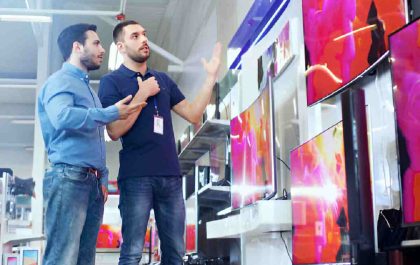Customer Centricity: Customer hotlines, chatbots, and personalized speeches are now part of every company’s standard repertoire in customer service. Because, Customers have become more critical. You alone decide which brand, which product, and which service you place your trust in and why.
The winners are those companies that have understood and taken into account their customers’ needs right from the start and, based on this, offer outstanding service. The digitization helps companies align their strategies and value chains to the wishes of their customers. Customer centricity is the magic word here. So if you want to remain spirited in the future, you would do well to deal with these issues.
Table of Contents
Digitization and Customer Centricity Go Hand in Hand
Markets are becoming more transparent and fast-moving – what is trendy today may long ago be out of date tomorrow. Local retailers are competing with international players, new communication channels, the Internet of Things. And new methods for real-time analysis of vast amounts of data are saturating the market. In short, the way we do business has changed and is creating new business models.
Today, digitization can be seen as an essential prerequisite for mastering the steadily growing challenges for retail and online retail and digital information procurement in business and society. It is the basis for retailers and retailers to permanently anchoring customer centricity in their own corporate structure and culture. Of course, the focus is on the customers. Because only those who develop a close relationship with them collect data that – if used correctly – enable an all-round view of customer needs. Companies can use these insights to develop their products and services further and optimize the customer journey. The logical consequence is: retailers should focus on their own digital transformation.

What are the Challenges?
Many companies tend to overthink these issues and thoroughly get through them before they take this step. But especially in the field of digitization, this is almost impossible in these fast-moving times. Often it is enough to get started, experiment, and proceed step by step. And yes, mistakes can be made. Here it is vital to establish resilience to the fear of the unknown. The old adage “learning by doing” has something quite refreshing in store in this regard.
Companies should also ensure that the transformation is not primarily about their own products and services but about developing a well-founded digital transformation strategy that creates the appropriate technical implementation options. This includes, for example, the IT infrastructure, technical equipment, or mobile-first approaches. Building on this, it is essential to develop a digital, open culture in which the company is able to try things out together with its customers and implement corresponding projects. Of course, it must ensure that it always protects privacy and customer data.
Companies that start the transformation of their own accord have a great advantage. You have ample time to develop a solid strategy and create the necessary budgets and resources. Suppose the pressure comes from outside, for example, due to the current Corona crisis or new regulations. In that case, it is frequently challenging to respond adequately (and above all promptly), as there may be financial bottlenecks or the necessary infrastructure is not yet available.
This is what happened to the Norwegian supermarket chain Coop. For example, when the Norwegian government took part in the corona crisis decided, groceries should now be offered more online to promote social distancing. However, Coop has managed to create a customer experience close to shopping in stationary retail. The customer has the opportunity to quickly and visibly look at his shopping cart at any time or to leave a message for the employee about what should be considered when packing the goods (for example, alternatives to products that are already out of stock).
This is How the Change Process Works
Change processes has a lot of complications, require flexibility and a great willingness to transform. It is not strange for them to meet with resistance because they mercilessly reveal where the company is lacking. Often, employees cannot identify with the upcoming changes, feel ignored, and face a fait accompli. To prevent this, the company must communicate transparently, clearly and credibly, why changes are pending, what advantages they have for the company and the employees, and, above all, that they can and should actively help shape it.
The management must then implement this promise gradually and together with the employees. An open ear for comments, feedback, and concerns is essential. This is the only way to create a constructive process. Depending on the company’s size, this is surely an association with a lot of organizational effort, but it is worthwhile. Because when the whole company pulls together, the transformation occurs from within. And only an intrinsic strategy that takes every employee with them and shows them why progression is necessary or necessary can ultimately be successful.

Customer Centricity in Practice
The premium chocolate manufacturer Neuhaus from Brussels has also embarked on the adventure of digital transformation and customer centricity. For a long time, the company relied on its own boutiques in Belgium and Germany as well as sales through various luxury department stores. However, in the course of growing digitalization, Neuhaus asked himself how the taste experience and could implement on-site advice online. The ultimate goal: All customers should benefit from the same shopping experience both online and offline.
Personalization is a crucial factor here. With individual product recommendations via e-mail and in the webshop and on the basis of customer accounts, Neuhaus is now analyzing chocolate taste, preferences, and buying habits and can thus address customers in a targeted manner. The company has also implemented a chatbot on the website that advises users. And also, provides information on the various chocolate creations, or provides information on topics such as ethical sources of supply, sustainability, and environmental impact. Neuhaus has developed special packaging for shipping to offer customers a high-quality “unboxing” experience.
So that online customers can also get to know the Neuhaus range, the Neuhaus Insiders company has set up a kind of newsletter club. The members benefit from free samples to get to know new collections; they receive a birthday present or gets invitation to exclusive VIP events.
We see: The path to a digital, customer-oriented company is complex and does not happen overnight. But it is precisely the possibilities of digitization, big data, and the involvement of customers. And users that open up new ways to approach the topic of customer centricity.
In the end, there are exactly three things that count: culture (trying things out), structure (using technologies and driving internal digitization), and culture (creating a shared digital culture between companies, employees, and customers). This is how successful customer centricity can be achieved in times of fast-moving digital processes.
Also Read: Gamification– Gaming Streams for Each Taste
Related posts
Featured Posts
Top 10 Electronics Stores Near Me In Helena, Arkansas, USA
Top 10 Electronics Stores Near Me In Helena, Arkansas, USA – Have you recently moved to Helena city and want…
GameStop Near Me South Dakota, United States
GameStop Near Me South Dakota, United States – Do you want to know about the GameStop stores near you in…



